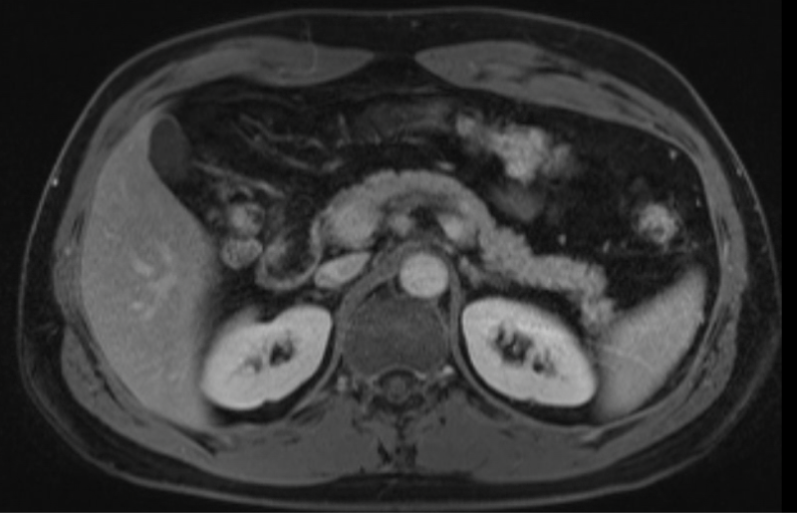Tuesday Poster Session
Category: Biliary/Pancreas
P4390 - Recurrent Carbohydrate Antigen 19-9 Elevation Associated With Marijuana Use: A Benign Mimicker of Pancreatic Malignancy
Tuesday, October 28, 2025
10:30 AM - 4:00 PM PDT
Location: Exhibit Hall

Pearl Aggarwal, MD (she/her/hers)
Cleveland Clinic
Cleveland, OH
Presenting Author(s)
Pearl Aggarwal, MD1, Saqr Alsakarneh, MD2, Farah Khraisat, MD3, Fatema Dinary, 4, Ibrahim Maghari, MD5, Sara Saleh, MD6, Niloufar Alimohammadi, MD7, Fazel Dinary, MD8
1Cleveland Clinic, Cleveland, OH; 2University of Missouri - Kansas City School of Medicine, Kansas City, MO; 3University of Florida, Jacksonville, FL; 4Case Western Reserve University, Westlake, OH; 5Parkview Medical Center, Fort Wayne, IN; 6Faculty of medicine,Hashemite University, Zarqa, Az Zarqa', Jordan; 7Anne Arundel Medical Center, Annapolis, MD; 8University Hospital, Cleveland, OH
Introduction: Carbohydrate Antigen 19-9 (CA 19-9) is a serum tumor marker commonly used to assess pancreatic malignancy. However, benign elevations can occur. We present a case of recurrent CA 19-9 elevation temporally associated with marijuana use, with normalization upon cessation.
Case Description/
Methods: A 49-year-old man with hypertension and chronic marijuana use was referred for elevated CA 19-9 following abdominal pain. Vitals were stable; exam revealed a non-tender abdomen with normoactive bowel sounds. Labs: WBC 7.4 × 10³/μL, hemoglobin 15.9 g/dL, ALP 59 U/L, AST 36 U/L, ALT 31 U/L, total bilirubin 0.7 mg/dL, and normal renal function. CA 19-9 measured 61.43 U/mL.
Magnetic resonance cholangiopancreatography (MRCP) showed normal pancreatic and biliary anatomy (Image 1). Endoscopic ultrasound (EUS) revealed diffuse parenchymal atrophy, hyperechoic strands, and lobularity without calcifications, masses, or honeycombing (Images 2A–B). He was advised to stop cannabis. Three months later, CA 19-9 decreased to 55.05 U/mL. At one-year follow-up, CA 19-9 rose to 78.49 U/mL. The patient admitted to resuming marijuana use. Repeat EUS and pancreatic biopsy revealed no new findings and no dysplasia. The CA 19-9 elevation was attributed to cannabis exposure. Social work support was engaged for cessation counseling.
Discussion: This case illustrates a reversible, benign CA 19-9 elevation associated with marijuana use. While typically linked to pancreatic adenocarcinoma, CA 19-9 can rise in conditions such as cholestasis, pancreatitis, cirrhosis, or fibrosis. Potential mechanisms include inflammation-driven secretion, impaired clearance, or cannabinoid receptor-mediated modulation of pancreatic and hepatic activity. Tetrahydrocannabinol (THC) interacts with CB1 and CB2 receptors in the pancreas and liver, potentially affecting immune tone, enzymatic activity, and bile secretion. In this case, biomarker trends closely mirrored marijuana use, suggesting a possible causative relationship. Awareness of such benign causes is essential to avoid unnecessary invasive testing. Further research is needed to clarify the dose-effect relationship and underlying biochemical mechanisms.
References:
Lee T, et al. World J Gastrointest Surg. 2020;12(12):468–490.
Desai S, et al. World J Oncol. 2023;14(1):4–14.

Figure: Image 1: Magnetic resonance cholangiopancreatography (MRCP) demonstrates normal pancreatic signal intensity and non-dilated pancreatic and biliary ducts, supporting the absence of obstructive or malignant pathology.

Figure: Image 2 ( A & B): Endoscopic ultrasound (EUS) revealing diffuse pancreatic parenchymal changes including lobularity and hyperechoic strands without masses or calcifications, consistent with benign pancreatic alterations.
Disclosures:
Pearl Aggarwal indicated no relevant financial relationships.
Saqr Alsakarneh indicated no relevant financial relationships.
Farah Khraisat indicated no relevant financial relationships.
Fatema Dinary indicated no relevant financial relationships.
Ibrahim Maghari indicated no relevant financial relationships.
Sara Saleh indicated no relevant financial relationships.
Niloufar Alimohammadi indicated no relevant financial relationships.
Fazel Dinary indicated no relevant financial relationships.
Pearl Aggarwal, MD1, Saqr Alsakarneh, MD2, Farah Khraisat, MD3, Fatema Dinary, 4, Ibrahim Maghari, MD5, Sara Saleh, MD6, Niloufar Alimohammadi, MD7, Fazel Dinary, MD8. P4390 - Recurrent Carbohydrate Antigen 19-9 Elevation Associated With Marijuana Use: A Benign Mimicker of Pancreatic Malignancy, ACG 2025 Annual Scientific Meeting Abstracts. Phoenix, AZ: American College of Gastroenterology.
1Cleveland Clinic, Cleveland, OH; 2University of Missouri - Kansas City School of Medicine, Kansas City, MO; 3University of Florida, Jacksonville, FL; 4Case Western Reserve University, Westlake, OH; 5Parkview Medical Center, Fort Wayne, IN; 6Faculty of medicine,Hashemite University, Zarqa, Az Zarqa', Jordan; 7Anne Arundel Medical Center, Annapolis, MD; 8University Hospital, Cleveland, OH
Introduction: Carbohydrate Antigen 19-9 (CA 19-9) is a serum tumor marker commonly used to assess pancreatic malignancy. However, benign elevations can occur. We present a case of recurrent CA 19-9 elevation temporally associated with marijuana use, with normalization upon cessation.
Case Description/
Methods: A 49-year-old man with hypertension and chronic marijuana use was referred for elevated CA 19-9 following abdominal pain. Vitals were stable; exam revealed a non-tender abdomen with normoactive bowel sounds. Labs: WBC 7.4 × 10³/μL, hemoglobin 15.9 g/dL, ALP 59 U/L, AST 36 U/L, ALT 31 U/L, total bilirubin 0.7 mg/dL, and normal renal function. CA 19-9 measured 61.43 U/mL.
Magnetic resonance cholangiopancreatography (MRCP) showed normal pancreatic and biliary anatomy (Image 1). Endoscopic ultrasound (EUS) revealed diffuse parenchymal atrophy, hyperechoic strands, and lobularity without calcifications, masses, or honeycombing (Images 2A–B). He was advised to stop cannabis. Three months later, CA 19-9 decreased to 55.05 U/mL. At one-year follow-up, CA 19-9 rose to 78.49 U/mL. The patient admitted to resuming marijuana use. Repeat EUS and pancreatic biopsy revealed no new findings and no dysplasia. The CA 19-9 elevation was attributed to cannabis exposure. Social work support was engaged for cessation counseling.
Discussion: This case illustrates a reversible, benign CA 19-9 elevation associated with marijuana use. While typically linked to pancreatic adenocarcinoma, CA 19-9 can rise in conditions such as cholestasis, pancreatitis, cirrhosis, or fibrosis. Potential mechanisms include inflammation-driven secretion, impaired clearance, or cannabinoid receptor-mediated modulation of pancreatic and hepatic activity. Tetrahydrocannabinol (THC) interacts with CB1 and CB2 receptors in the pancreas and liver, potentially affecting immune tone, enzymatic activity, and bile secretion. In this case, biomarker trends closely mirrored marijuana use, suggesting a possible causative relationship. Awareness of such benign causes is essential to avoid unnecessary invasive testing. Further research is needed to clarify the dose-effect relationship and underlying biochemical mechanisms.
References:
Lee T, et al. World J Gastrointest Surg. 2020;12(12):468–490.
Desai S, et al. World J Oncol. 2023;14(1):4–14.

Figure: Image 1: Magnetic resonance cholangiopancreatography (MRCP) demonstrates normal pancreatic signal intensity and non-dilated pancreatic and biliary ducts, supporting the absence of obstructive or malignant pathology.

Figure: Image 2 ( A & B): Endoscopic ultrasound (EUS) revealing diffuse pancreatic parenchymal changes including lobularity and hyperechoic strands without masses or calcifications, consistent with benign pancreatic alterations.
Disclosures:
Pearl Aggarwal indicated no relevant financial relationships.
Saqr Alsakarneh indicated no relevant financial relationships.
Farah Khraisat indicated no relevant financial relationships.
Fatema Dinary indicated no relevant financial relationships.
Ibrahim Maghari indicated no relevant financial relationships.
Sara Saleh indicated no relevant financial relationships.
Niloufar Alimohammadi indicated no relevant financial relationships.
Fazel Dinary indicated no relevant financial relationships.
Pearl Aggarwal, MD1, Saqr Alsakarneh, MD2, Farah Khraisat, MD3, Fatema Dinary, 4, Ibrahim Maghari, MD5, Sara Saleh, MD6, Niloufar Alimohammadi, MD7, Fazel Dinary, MD8. P4390 - Recurrent Carbohydrate Antigen 19-9 Elevation Associated With Marijuana Use: A Benign Mimicker of Pancreatic Malignancy, ACG 2025 Annual Scientific Meeting Abstracts. Phoenix, AZ: American College of Gastroenterology.
